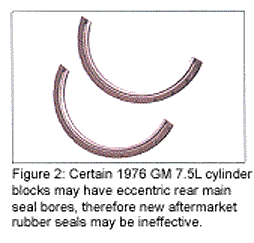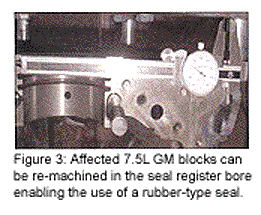Engine Builders: The AERA Technical Committee offers the following information on coolant loss on 2001-2004 GM 6.6L diesel VIN 1 engines. Some owners may comment on engine coolant loss with no visible leaks. Excessive white smoke or a coolant type odor coming from the exhaust pipe, along with low coolant levels, may indicate coolant entering the combustion chamber.
This condition may be caused by engine coolant entering the cylinder due to a dirty or damaged seal between the fuel injector sleeve and the cylinder head. Not all fuel injector sleeves may be leaking. A proper pressure test of the cylinder head will reveal any leaking fuel injector sleeves. Once the leaking injector sleeves have been found, remove the injector sleeve from the cylinder head using a fuel injector sleeve remover/installer tool p/n J45910.
After the sleeve has been removed, inspect the inside of the fuel injector sleeve for damage to the injector sealing surface. Damage to this portion of the fuel injector sleeve may indicate a loose injector caused by improper installation or a missing copper washer. A loose injector will allow the fuel injector and the injector sleeve to bounce inside of the cylinder head, resulting in coolant leaking into the cylinder. If damage is found, replace the damaged components.
Inspect the tapered sealing surface of the cylinder head and the fuel injector (shown in Figure 1) for evidence of machining debris, carbon tracking, improper machining or damage. If improper machining or damage is found, replacement of the affected part is recommended. If there is machining debris found on the fuel injector sleeve or cylinder head sealing surfaces, clean the debris and reinstall the fuel injector sleeve using the fuel injector sleeve remover/installer tool .

Engine Builders: The AERA Technical Committee offers the following information regarding a cylinder block caution for 1976 GM 7.5L engines. These engines were manufactured by the Pontiac Division of General Motors and mark the end of production for the large bore big block engine.
The original rear main oil seal design for this engine family used a rope seal material that is time consuming to install and often leaked. In recent years, engine builders have successfully used an available aftermarket rubber Viton® rear main oil seal for this engine (Figure 2).
It has been reported, however, that certain cylinder blocks with the casting number 500813 may have non-concentric rear main seal bores. A quick check on a disassembled block can be made by measuring, as shown in Figure 3, below, and comparing both side measurements.

Obviously, the closer the two measurements are to each other, the less likely there will be problem using the rubber seal. The greatest difference in depth has been measured near the block/cap split line. As an example, using the 2-piece rubber rear main seal with a block and .026″ difference in the observed measurement did not provide a leak proof seal.
While non-concentricity was not such an issue with the original rope seal, a solid, rubber Viton seal requires a more “exact” seal register to provide a concentric sealing surface. Another benefit is the significant reduction in friction created by the previous rope design.
Affected blocks could be successfully re-machined in the seal register bore and use of an appropriate shim seal will allow use of the seal shown above. The cost to do so, however, may be more than the cost of obtaining a non-affected block.
For information on receiving all of AERA’s regular monthly technical bulletins and other association services and benefits, call toll free 888-326-2372 or send an e-mail to [email protected].













